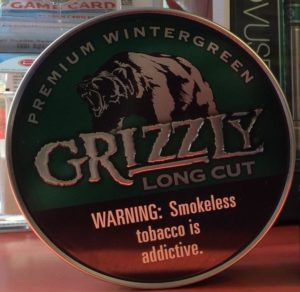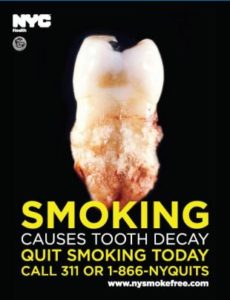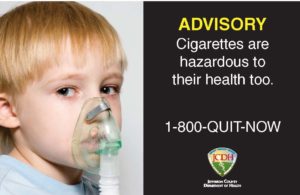POS Health Warnings
Just as the tobacco industry uses the point of sale as its primary advertising, marketing and promotional channel, tobacco control partners can implement health warnings in the retail environment to counter industry tactics. Health warnings can communicate important health messages as well as promote cessation services.
What are POS Health Warnings?
Health warnings displayed at the point of sale are a counter-advertising mechanism involving written, and sometimes pictorial (or “graphic”) warnings of the health impacts of tobacco use along with information about cessation services. There are three main types of POS health warnings:
Warnings on tobacco packaging
 Smokeless tobacco: Currently, health warnings are required to cover at least 30% of both principle sides of smokeless tobacco packages in the US;
Smokeless tobacco: Currently, health warnings are required to cover at least 30% of both principle sides of smokeless tobacco packages in the US;- Cigarettes: cigarette packages are currently required to carry one of four Surgeon General’s warnings, with no size or placement specification (Read more), although they are usually found on the side of the packaging in small typeface. In March 2020, the FDA issued a final rule, requiring new text and graphic health warnings that showing some of the serious but lesser known health risks of cigarette smoking, such as heart disease, type 2 diabetes, cataracts, erectile dysfunction and bladder cancer. The eleven new graphic warnings will cover the top 50% of the front and back of cigarette packages, as well as 20% of the top of cigarette advertisements. The warnings, which are not required for any other tobacco product, will be randomly distributed across cigarette packages and rotated multiple times per year in cigarette advertisements. This new rule comes after years of litigation and delay following the original required implementation in the 2009 Family Smoking Prevention and Tobacco Control Act (learn more here), and the tobacco industry is attempting to challenge the new rule as well. Enforcement of these warning labels has been delayed until at least January 2026. In January 2025 a District Court ruling paused implementation on the grounds that the FDA was only authorized to require 9 different warnings rather than 11. Worldwide, many countries have instituted graphic warning labels as part of the World Health Organization’s Framework Convention on Tobacco Control. Review the International Status Report on Cigarette Package Health Warnings.
- Cigars: Under the FDA’s deeming regulations, six rotating warning labels must be randomly displayed and distributed on cigar packages and rotated quarterly in advertisements Retailers who sell individual, unpackaged cigars must display a sign of all six warning statements by each cash register as specified in the law. The health warnings are required to appear on at least 30% of each of the two principal display panels of the package.
- Nicotine warning. In May 2016, FDA announced “deeming” regulations that will require all covered tobacco products (including e-cigarettes, hookah, pipe tobacco, novel and future products, as well as roll-your-own tobacco) to have health warnings that state, “WARNING: This product contains nicotine. Nicotine is an addictive chemical.” by May of 2018. For products that do not contain nicotine at detectable levels, the warning is revised to read: “This product is made from tobacco.” E-liquids that do not contain tobacco or nicotine, or are not derived from tobacco or nicotine do not meet the definition of a “covered tobacco product”, under the new FDA Deeming regulations, and they will not be required to carry an addiction warning.
The warning statements required for tobacco packaging by the FDA’s deeming regulations must be printed in at least 12-point font size. For products with packages that are too small, the warning must be placed on the outer carton, wrapper, or on a tag attached to the product.
 Warnings on tobacco advertisements
Warnings on tobacco advertisements
- Smokeless tobacco: Currently, health warnings are required to cover at least 20% of smokeless tobacco advertisements. Additionally, the Comprehensive Smoking Education Act of 1984 requires Surgeon General’s warnings on all cigarette advertisements.
- Cigarettes: The 2009 FDA Act would have required graphic warnings to cover 20% of cigarette advertisements, but this was struck down as part of the ruling on graphic warning labels (Read more about the cases). The FDA may appeal or reissue new warnings in the future that adhere to principles in the legal opinion
- Cigars: Under the FDA’s deeming regulations, six warning labels must be randomly displayed and rotated quarterly in advertisements. The health warnings must appear on at least 20% of the area of the print or other visual advertisements.
- Nicotine warning. Th same health warnings required for packaging of all tobacco products newly-covered by deeming that states, “WARNING: This product contains nicotine Nicotine is an addictive chemical” or “This product is made from tobacco” will also be required for all tobacco advertisements as of May 2018. In addition to the requirement to be printed in at leas 12-point font size, the warning statements must also occupy “the greatest possible portion of the warning area set aside for the required text,” meaning the text should be larger on larger print advertisements.
Stand-alone health warning signs
Stand-alone health warning signs may be implemented via several mechanisms:
- Law or resolution. For example, the New York City Board of Health passed a resolution requiring health warnings wherever tobacco products were sold, although it was subsequently struck down as a violation of the Federal Cigarette Labeling and Advertising Act (FCLAA). The FCLAA only applies to cigarettes though, so there may be opportunities to require warnings for other tobacco products (OTPs). Since the court only ruled that the regulation violated FCLAA, it is unclear how they may rule on First Amendment issues. Carefully consult legal advice and review ChangeLab Solutions’ resource for more details on what the NYC ruling means for other cities.
 The New York City Board of Health passed a resolution in September 2009 requiring health warnings and cessation information to be placed near the cash register or near the tobacco product display everywhere tobacco is sold in New York City (read more about the original proposal). Preliminary research with adult current smokers and recent quitters both before and after the signs were posted showed an 11% increase in respondents who were thinking about quitting smoking. Unfortunately, in June 2010, the regulation was challenged in court by Phillip Morris, R.J. Reynolds, Lorillard, and a convenience store trade group in 23-34 94th St. Grocery Corp. v. N.Y. City Board of Health. In December 2010, the court ruled that implementation of the warnings was preempted by the Federal Cigarette Labeling and Advertising Act (FCLAA). This ruling was upheld in the U.S. Court of Appeal for the Second Circuit in July 2012. Review the following resources for more information about New York City’s resolution, the legal battle, and what it means for other cities looking to implement similar policies:
The New York City Board of Health passed a resolution in September 2009 requiring health warnings and cessation information to be placed near the cash register or near the tobacco product display everywhere tobacco is sold in New York City (read more about the original proposal). Preliminary research with adult current smokers and recent quitters both before and after the signs were posted showed an 11% increase in respondents who were thinking about quitting smoking. Unfortunately, in June 2010, the regulation was challenged in court by Phillip Morris, R.J. Reynolds, Lorillard, and a convenience store trade group in 23-34 94th St. Grocery Corp. v. N.Y. City Board of Health. In December 2010, the court ruled that implementation of the warnings was preempted by the Federal Cigarette Labeling and Advertising Act (FCLAA). This ruling was upheld in the U.S. Court of Appeal for the Second Circuit in July 2012. Review the following resources for more information about New York City’s resolution, the legal battle, and what it means for other cities looking to implement similar policies:
- Public Health Law Center’s “New York City Graphic Warning Sign Requirement & Litigation” fact sheet
- Brief of Amicus Curiae filed in support of the New York City Board of Health on behalf of several city public health departments
- ChangeLab Solutions’ FAQs on the New York City rulings
- Voluntary agreement. Jefferson County, Alabama has instituted a voluntary agreement with tobacco retailers in its community to implement graphic health warning signs.
 Jefferson County, Alabama pioneered an innovative program based on voluntary commitments of store owners to the health of their communities. The United Way of Central Alabama and the Jefferson County Department of Health have worked together to start a program in which retailers post health warning signs in their stores. Signs were created based partially on the new graphic warning labels required by the 2009 FDA Act. Encouragingly, 51 convenience store owners voluntarily agreed to post the warning signs in their place of business, demonstrating strong commitment to the health of their communities. Through these signs and other communication strategies, the number of callers to the quitline (1-800-QUIT-NOW) exposed to this service by the media has more than doubled.
Jefferson County, Alabama pioneered an innovative program based on voluntary commitments of store owners to the health of their communities. The United Way of Central Alabama and the Jefferson County Department of Health have worked together to start a program in which retailers post health warning signs in their stores. Signs were created based partially on the new graphic warning labels required by the 2009 FDA Act. Encouragingly, 51 convenience store owners voluntarily agreed to post the warning signs in their place of business, demonstrating strong commitment to the health of their communities. Through these signs and other communication strategies, the number of callers to the quitline (1-800-QUIT-NOW) exposed to this service by the media has more than doubled.
- Purchasing advertising space. Delaware’s “The Dirty Truth” campaign took the novel approach of purchasing space (e.g., gas station pump toppers and bus ads) for placement of graphic health warnings.

These type of antismoking advertisements in the retail environment can reduce the urge to smoke among people who currently smoke.[10]
The evidence for implementing POS health warnings
Despite decades of work in educating the public about the risks of tobacco use, research shows that smokers have little knowledge of the risks of tobacco use other than lung cancer and underestimate their risk for tobacco-related illness. [1,2] Health warnings have the potential to counter this knowledge gap and encourage cessation, whether they are presented in antismoking ads [10] or in graphic warnings on packages [3] A growing evidence base supports the implementation of health warnings, with strong evidence supporting the use of graphic imagery over text-only messages.[4] Moreover, there is broad public support for increasing the size of health warnings on cigarette packs, including among smokers.[5] A nationally representative study conducted in 2014-2015 found that nearly three-quarters (72%) of adults supporting warning labels as large as 75% of a cigarette pack, and even larger percentages of adults had supported warning labels covering at least 50% of a cigarette pack.[5]
A 2015 meta-analysis of pictorial cigarette pack warnings revealed that pictorial warning labels were better than text-only warnings in eliciting negative smoking attitudes among participants.[6] Participants reported a decreased desire to start smoking and an increased desire to quit smoking after viewing the pictorial warnings.[6] Pictorial warning labels were also more effective in grabbing the participants’ attention and provoking stronger emotional reactions than the text-only warnings.[6] Similarly, a recent randomized control trial found smokers using cigarettes packs with graphic warning labels had more quit attempts and quit intentions than those using packs with text-only labels.[7] These effects may also be stronger when graphic health warning labels are larger and placed on plain packaging. [8] Modeling conducted by researchers in 2016 showed that the addition of pictorial health warnings to cigarette packs in the US would reduce smoking prevalence by an additional 10% over the long term.[9] Over the next 50 years, the model predicts that pictorial health warnings would prevent 652,800 smoking attributable deaths, 46,6000 low-birth weight cases, 73,600 preterm births, and 1000 cases of sudden infant death syndrome.[9] Another simulation found that if graphic health warnings on cigarette packages had been implemented in 2012 (as originally planned by the FDA), 718,000 smoking-attributable deaths could have been avoided and 11.2 million life-years gained by 2100.[10] However, if they are implemented in 2022 (as currently planned after many delays due to industry litigation and other factors), they could lead still lead to the avoidance of 539,000 smoking-attributable deaths and 7.9 million life-years gained by 2100.[10]
The World Health Organization (WHO) Framework Convention on Tobacco Control (FCTC) requires graphic health warnings on product packages in the 177 countries that have ratified. See Tobacco Labeling Resource Centre for health warning examples from around the world for examples. According to data from the Global Adult Tobacco Survey (GATS), in 14 of the countries with graphic cigarette package health warnings:
- Greater than 90% of smokers noticed a health warning in the previous 30 days;
- Greater than 50% of smokers were thinking about quitting because of the warnings in 6 countries; and
- Greater than 25% of smokers were thinking about quitting because of the warnings in all countries except one.
Read more on the research behind the impact of health warnings:
- Campaign for Tobacco Free Kids’ “Tobacco Warning Labels: Evidence of Effectiveness”
- MMWR on “Cigarette Package Health Warnings and Interest in Quitting Smoking — 14 Countries, 2008—2010”
- WHO’s “Evidence Brief: How large pictorial health warnings on the packaging of tobacco products affect knowledge and behaviour“
Best Practices for Getting Started
- Conduct public opinion surveys to measure awareness of and support for point of sale policies.
- Engage stakeholders. Review the CDC’s Best Practices for Comprehensive Tobacco Control Programs for tips.
- Consult legal experts. The information on this site and associated resources are no substitute for actual legal advice. Consider how you may circumvent the legal challenges faced by New York City.
- Consider voluntary programs, as done in Jefferson County, Alabama.
- Work closely with retailers if implementing a policy. Consider drafting a Frequently Asked Questions guide.


